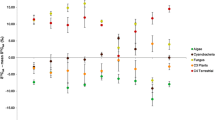Summary
Stable carbon isotope analysis was used to define the food sources of bivalve Chione (Austrovenus) stutchburyi in the Avon-Heathcote Estuary, Christchurch, New Zealand. δ13C values of C. stutchburyi tissue were significantly different (from -16.7‰ to -23.5‰ relative to the PDB standard) at five locations separated by less than 4 km but subject to different hydrological regimes. This is related to differences in the isotopic composition of the suspended particulate matter of the inflowing water. C. stutchburyi is shown to utilise carbon of terrestrial and marine origin depending upon its position within the estuary and local hydrology.
Similar content being viewed by others
References
Bender MM (1971) Variations in the 13C/12C ratios of plants in relation to the pathway of photosynthetic carbon dioxide fixation. Phytochemistry 10:1239–1244
Bender MM, Rouhani I, Vines HM, Black CC (1973) 13C/12C ratio changes in crassulacean acid metabolism plants. Plant Physiol 53:427–430
Benedict CR (1978) The fractionation of stable carbon isotopes in photosynthesis. What's New? Plant Physiol 9:13–16
Botello AV, Mandelli EF, Macko S, Parker PL (1980) Organic carbon isotope ratio of recent sediments from coastal lagoons of the Gulf of Mexico, Mexico. Geochim Cosmochim Acta 44:557–559
Burnett WC, Schaeffer OA (1980) Effect of ocean dumping on 13C/12C ratios in marine sediments from the New York Bight. Est Coastal Mar Sci 11:605–611
Craig H (1957) Isotopic standards for carbon and oxygen and correction factors for mass-spectrometric analysis of carbon dioxide. Geochim Cosmochim Acta 12:133–149
DeNiro MJ, Epstein S (1978) Influence of diet on the distribution of carbon isotopes in animals. Geochim Cosmochim Acta 42(5):495–506
Fry B, Joern A, Parker PL (1978) Grasshopper food web analysis: use of carbon isotope ratios to examine feeding relationships among terrestrial herbivores. Ecology 59(3):498–506
Fry B, Parker PL (1978) Animal diet in Texas seagrass meadows: δ13C evidence for the importance of benthic plants. Est Coastal Mar Sci 8:499–509
Haines EB (1977) The origins of detritus in Georgia salt marsh estuaries. Oikos 29:254–260
Haines EB, Montague CL (1979) Food sources of estuarine invertebrates analysed using 13C/12C ratios. Ecology 60:48–56
Hoefs J (1980) Stable Isotope Geochemistry (2nd revised ed.). Springer-Verlag, Berlin, 208 pp
Knox GA, Kilner AR (1973) The Ecology of the Avon-Heathcote Estuary. Unpublished report to the Christchurch Drainage Board by the Estuarine Research Unit, Dept of Zoology, University of Canterbury, 358 pp
McConnaughey T, McRoy CP (1979A) Food-web structure and the fractionation of carbon isotopes in the Bering Sea. Mar Biol 53(3):257–262
McConnaughey T, McRoy CP (1979B) 13C label identifies Eelgrass (Zostera marina) carbon in an Alaskan estuarine food web. Mar Biol 53:263–269
Minson DJ, Ludlow MM, Troughton JH (1975) Differences in natural carbon isotope ratios of milk and hair from cattle grazing tropical and temperate pastures. Nature: 256:602
Mosora F, LaCroix M, Duchesne J (1971) Recherches sur les variations du rapport isotopique 13C/12C, en fonction de la respiration et de la nature des tissus, chez les animaux supérieurs. CR Acad Sci Ser D (Paris) 273:1423–1425
Nissenbaum A (1973) The organic geochemistry of marine and terrestrial humic substances: Implications of carbon and hydrogen isotope studies. Adv Org Geochem 1973:39–52
Peters KE, Sweeney RE, Kaplan IR (1978) Correlation of carbon and nitrogen stable isotope ratios in sedimentary organic matter. Limnology and Oceanography 23:598–604
Rau G (1978) Carbon-13 Depletion in a subalpine lake: Carbon flow implications. Science 201:901–902
Rau G (1980) Carbon-13/carbon-12 variation in subalpine lake aquatic insects: Food source implications. Can J Fish Aquat Sci 37:742–746
Rau G, Hedges JI (1979) Carbon 13 depletion in a hydrothermal vent mussel: Suggestion of a chemosynthetic food source. Science 203:648–649
Rau GH, Sweeney RE, Kaplan IR, Mearns AJ, Young DR (1981) Differences in animal 13C, 15N and D abundance between a polluted and an unpolluted coastal site: Likely indicators of sewage uptake by a marine food web. Est Coast Shelf Sci 13:701–707
Smith BN, Epstein S (1970) Biogeochemistry of the stable isotopes of hydrogen and carbon in salt marsh biota. Plant Physiol 46:738–742
Smith BN, Epstein S (1971) Two categories of 13C/12C ratios for higher plants. Plant Physiol 47:380–384
Stephenson RL (1981) Aspects of the energetics of the cockle Chione (Austrovenus) stutchburyi in the Avon-Heathcote Estuary, Christchurch, New Zealand, Ph D thesis, Dept of Zoology, University of Canterbury, Christchurch, New Zealand, 165 pp
Stout JD, Rafter TA, Troughton JH (1975) The possible significance of isotopic ratios in Paleoecology. In Suggate RP, Cresswell MM (ed), Quaternary Studies. Royal Society of NZ, Wellington p 279–286
Sweeney RE, Kalil EK, Kaplan IR (1980) Characterization of domestic and industrial sewage in Southern California coastal sediments using nitrogen, carbon, sulphur and uranium tracers. Mar Env Res 3:215–224
Tan FC, Strain PM (1979 A) Organic carbon isotope ratios in recent sediments in the St Lawrence Estuary and the Gulf of St Lawrence. Est Coastal Mar Sci 8:213–225
Tan FC, Strain PM (1979 B) Carbon Isotope ratios of particulate organic matter in the Gulf of St Lawrence. J Fish Res Bd Canada 36(6):678–682
Tieszen LL, Hein D, Qvortrup SA, Troughton JH, Imbamba SK (1979) Use of δ13C values to determine vegetation selectivity in East African herbivores. Oecologia (Berl) 37:351–359
Troughton JH (1971) Aspects of the evolution of the photosynthetic carboxylation reaction in plants. In Hatch MD, Osmond CB, Slayter RO (ed) Photosynthesis and Respiration, Wiley Interscience, New York, p 124–129
Author information
Authors and Affiliations
Rights and permissions
About this article
Cite this article
Stephenson, R.L., Lyon, G.L. Carbon-13 depletion in an estuarine bivalve: Detection of marine and terrestrial food sources. Oecologia 55, 110–113 (1982). https://doi.org/10.1007/BF00386725
Received:
Issue Date:
DOI: https://doi.org/10.1007/BF00386725




